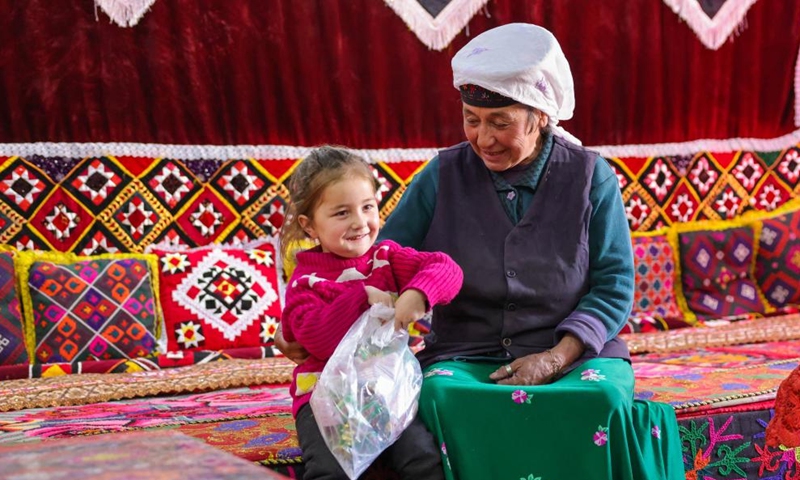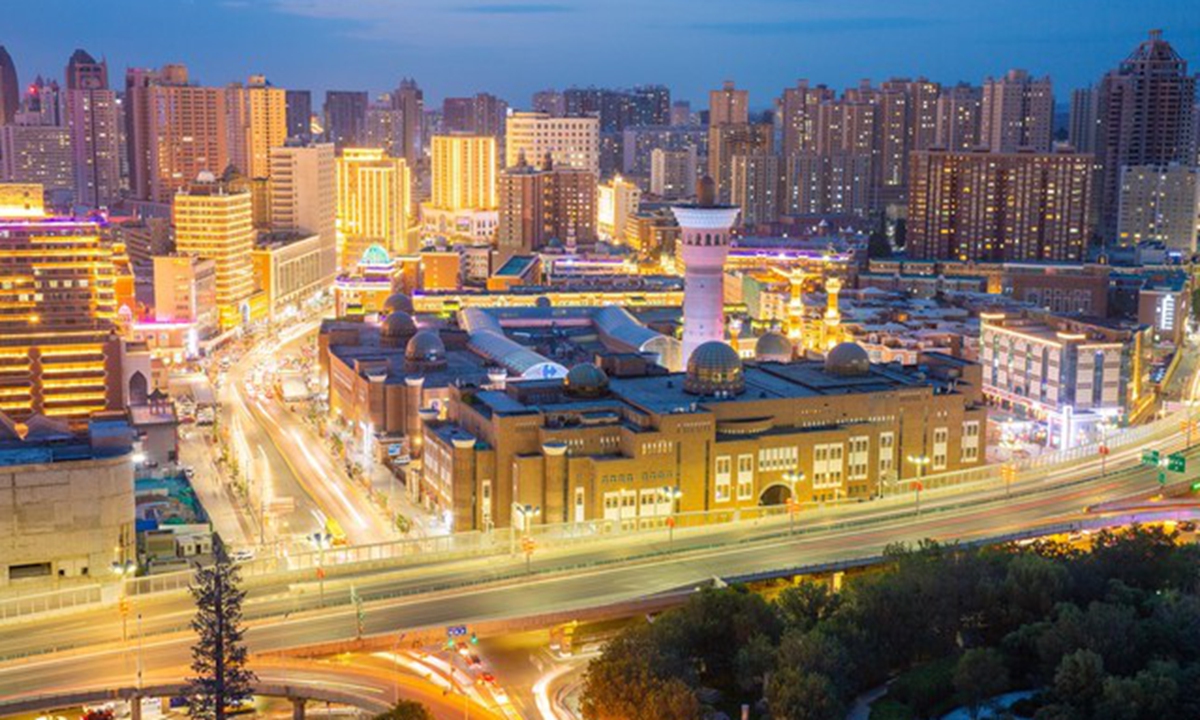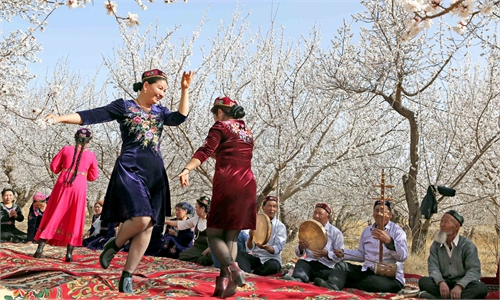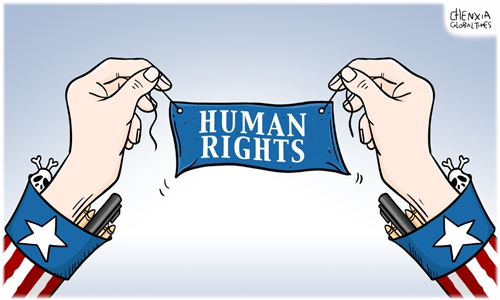China’s hard-fought successful governance in Xinjiang a resolute response to ‘Three Evil Forces’

A child chats with her family at home in Rasekam Village of Taxkorgan Tajik Autonomous County, northwest China's Xinjiang Uygur Autonomous Region, Feb. 24, 2022.Photo:Xinhua
After the founding of the People's Republic of China (PRC) in 1949, Xinjiang entered a new stage of historical development within a socialist society. Under the leadership of the Communist Party of China, the people of all ethnic groups in Xinjiang have forged ahead in unity, working with the people of the whole country to jointly explore a socialist system with Chinese characteristics, prosper the society, economy and culture, and stabilize borders. Over the past 70 years, Xinjiang has gone through the storms of history, embraced the dazzling rainbow after storms, and has been thinking about how to lead the region, with its magnificent scenic beauty and unique culture, to an even brighter future.Xinjiang is located in Northwest China, and faces a complicated internal and external environment. As the largest provincial level region in China, Xinjiang covers an area of more than 1.66 million square kilometers. It borders eight countries - Mongolia, Russia, Kazakhstan, Kyrgyzstan, Tajikistan, Afghanistan, Pakistan and India, with a borderline extending more than 5,600 kilometers. These neighboring countries have huge cultural differences and different political systems. They have always been the arena of world politics, and traditional security issues have always affected Xinjiang. In Xinjiang, the Altai Mountains, the Tianshan Mountains and the Karakoram Mountains make traffic difficult. The deserts and the Gobi cover more than 716,000 square kilometers. The traditional oasis farming and alpine nomadic production methods have deep roots in the region. When the People's Republic of China was founded, there were 13 ethnic groups in Xinjiang including Uygur, Han, Kazak, Mongolian, Xibo and Hui. The long-term separatist rule by warlords had shattered the political system in Xinjiang, the intertwined foreign forces seriously eroded China's sovereignty, and education and infrastructure were extremely weak. Besides, the "East Turkistan" separatism and security threats it caused such as religious extremism and terrorism threaten the stability of Xinjiang. The task of governance in Xinjiang has been arduous and a "world-class" challenge.
After the founding of the PRC, the Chinese government has been brave in innovation when it comes to Xinjiang governance. In the construction of the political system, the country ended the history of separation among warlords in Xinjiang and the interference of foreign forces. Based on the principles of ethnic equality, unity, mutual assistance, fraternity, common development and common prosperity, "Xinjiang province" was changed into Xinjiang Uygur Autonomous Region in 1955. Meanwhile, all major ethnic groups in Xinjiang established corresponding autonomous areas, becoming the only provincial administration in the country with a three-level system of autonomous region, autonomous prefectures and autonomous counties. The establishment of the system of ethnic autonomy in Xinjiang has guaranteed the political equality of all ethnic groups. Meanwhile, to meet the needs of Xinjiang's social stability, border security and overall development, Xinjiang has inherited the historical tradition and established the Xinjiang Production and Construction Corps. The history of contemporary Xinjiang has proved that the system of regional ethnic autonomy and the Xinjiang Production and Construction Corps are innovative systems suitable for Xinjiang.
The new political system has stimulated enthusiasm and creativity of all ethnic groups, and Xinjiang has achieved rapid economic and social development. Xinjiang's GDP has increased from 791 million yuan in 1952 to 1,598 billion yuan in 2021, with a per capita GDP of $9,568. Xinjiang has basically established a system of pillar industries such as petroleum, chemical industry, non-ferrous metals, steel, electricity and coal, and built railways, high-speed railways, highways, and aviation networks. Xinjiang has made all-round progress in social undertakings covering informatization, education, medical care, health care, culture and sports. The population of Xinjiang has maintained a good development trend. In China's first national population census in 1953, Xinjiang had a population of 4.78 million, with a Uygur population of 3.6 million. While in the seventh national population census in 2020, the total population of Xinjiang reached 25.85 million, and the Uygur population reached 11.62 million. Xinjiang maintains social stability in accordance with the law and ensures the safety and property of people of all ethnic groups. Combating the "Three Evil Forces" is an important part of it. According to the needs of governance practices, the central government and Xinjiang have formulated a series of laws and regulations to crack down on the "Three Evil Forces" in accordance with the law, and insisted on putting preventive counter-terrorism efforts first.
China's long-term policy of supporting Xinjiang has greatly promoted its development. In 2010, the Chinese central government convened the first central symposium on work related to Xinjiang. The symposium made a decision that 19 provinces and municipalities across the country will support Xinjiang, focus on infrastructure construction, develop industries, and expand the employment of Uygur people, especially in southern Xinjiang. These provinces and municipalities actively organized people from Xinjiang to work in their places, established an e-commerce platform to promote the domestic sales of Xinjiang agricultural products, facilitated tourists to travel to Xinjiang, and invited Xinjiang officials to work in exchange programs.

A night view of Xinjiang International Grand Bazaar in Urumqi. Photo: IC
The protection of ethnic cultures in Xinjiang has been an important policy for China's governance of Xinjiang. In 1951 and 1954 the central government made recordings of the music of the Twelve Muqams to rescue the Muqam arts.. Since the 1960s, China has compiled and published various folk oral literary works such as the Kirgiz epic Manas, 10 art collections of various ethnic groups including music, dance and opera, and implemented regulations to protect Xinjiang's intangible cultural heritage. China attaches great importance to the protection of cultural relics in Xinjiang, establishing 189 cultural relic protection institutions at all levels in the region. China has also established a leading group and an office for the planning and publication of ancient books, an ancient book protection center, an ancient book restoration center and other specialized institutions. China has also established a special collection of ethnic minority ancient books, extensively collecting and protecting ancient books. At present, all ethnic groups in Xinjiang mainly use 10 languages and scripts. While promoting and standardizing the use of national common language and script, China protects the use and development of all ethnic groups' own languages and scripts in accordance with the law.With the proposal of the Belt and Road Initiative, Xinjiang has become the frontier of China's opening to the West and the core area of the Silk Road Economic Belt, taking on the important task of participating in international economic and cultural exchanges and cooperation. Xinjiang has become an important hub connecting China with Central Asia, South Asia, West Asia and East Europe, and will play an important supporting and leading role in the future economic and social development of the Asian inland. Since 2020, the COVID-19 pandemic has ravaged the world. Xinjiang has not only well controlled the epidemic, but also supported neighboring countries with medicines, food and daily necessities, becoming the forefront of China's foreign aid in special times.
Current day Xinjiang governance is constantly innovating, developing and improving on the basis of absorbing the experience of previous central governments. Its basic logic shows China's concept of governing Xinjiang according to the rule of law, reflecting the idea of people first and meeting people's ever-growing needs for a better life.
The author is a research fellow at Chinese Borderland Research Institute of the Chinese Academy of Social Sciences. opinion@globaltimes.com.cn



